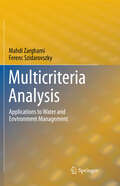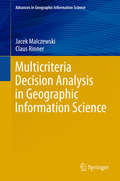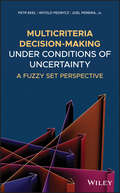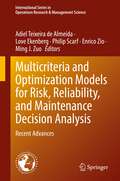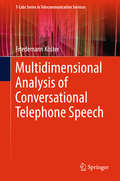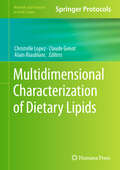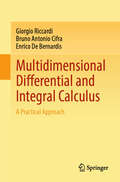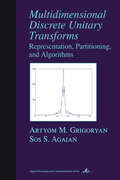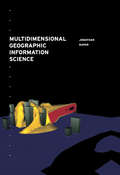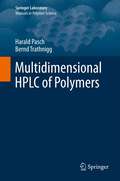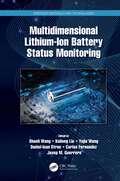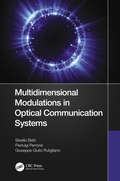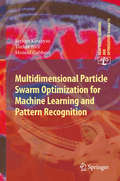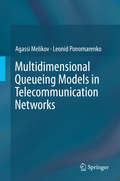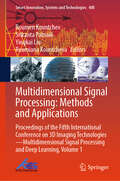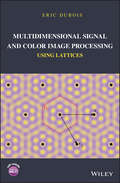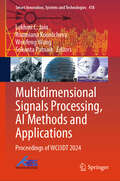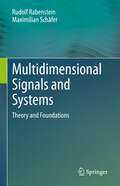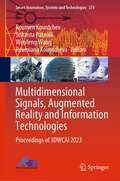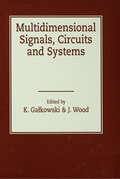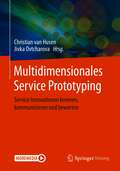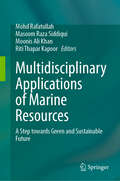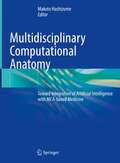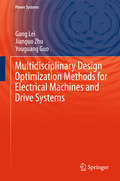- Table View
- List View
Multicriteria Analysis: Applications to Water and Environment Management
by Ferenc Szidarovszky Mahdi ZarghamiMulticriteria analysis is one of the most important fields of decision science. This book gives an outline of the formulation of an appropriate model and presents a comprehensive summary of the most popular methods for solving multicriteria decision problems. In addition to the classical approach the book introduces fuzzy and stochastic methodology, models with uncertainty, social choice and conflict resolution. All methods are illustrated with easy to follow simple examples. At the end of each chapter detailed case studies are given in water and environment management including inter-basin water transfer, urban water management, water allocation, groundwater quality management, forest treatment, ranking water resources projects, reservoir planning, water distribution network design and long-term watershed management. The new methodology and the wide variety of case studies are not easily accessible elsewhere.
Multicriteria Decision Analysis in Geographic Information Science
by Jacek Malczewski Claus RinnerThis book is intended for the GIS Science and Decision Science communities. It is primarily targeted at postgraduate students and practitioners in GIS and urban, regional and environmental planning as well as applied decision analysis. It is also suitable for those studying and working with spatial decision support systems. The main objectives of this book are to effectivley integrate Multicriteria Decision Analysis (MCDA) into Geographic Information Science (GIScience), to provide a comprehensive account of theories, methods, technologies and tools for tackling spatial decision problems and to demonstrate how the GIS-MCDA approaches can be used in a wide range of planning and management situations.
Multicriteria Decision-Making Under Conditions of Uncertainty: A Fuzzy Set Perspective
by Witold Pedrycz Petr Ekel Joel Pereira Jr.A guide to the various models and methods to multicriteria decision-making in conditions of uncertainty presented in a systematic approach Multicriteria Decision-Making under Conditions of Uncertainty presents approaches that help to answer the fundamental questions at the center of all decision-making problems: "What to do?" and "How to do it?" The book explores methods of representing and handling diverse manifestations of the uncertainty factor and a multicriteria nature of problems that can arise in system design, planning, operation, and control. The authors—noted experts on the topic—and their book covers essential questions, including notions and fundamental concepts of fuzzy sets, models and methods of multiobjective as well as multiattribute decision-making, the classical approach to dealing with uncertainty of information and its generalization for analyzing multicriteria problems in condition of uncertainty, and more. This comprehensive book contains information on "harmonious solutions" in multiobjective problem-solving (analyzing X, F> models), construction and analysis of X, R> models, results aimed at generating robust solutions in analyzing multicriteria problems under uncertainty, and more. In addition, the book includes illustrative examples of various applications, including real-world case studies related to the authors’ various industrial projects. This important resource: Explains the design and processing aspect of fuzzy sets, including construction of membership functions, fuzzy numbers, fuzzy relations, aggregation operations, and fuzzy sets transformations Describes models of multiobjective decision-making (X. M> models), their analysis on the basis of using the Bellman-Zadeh approach to decision-making in a fuzzy environment, and their diverse applications, including multicriteria allocation of resources Investigates models of multiattribute decision-making (X, R> models) and their analysis on the basis of the construction and processing of fuzzy preference relations as well as demonstrating their applications to solve diverse classes of multiattribute problems Explores notions of payoff matrices and fuzzy-set-based generalization and modification of the classic approach to decision-making under conditions of uncertainty to generate robust solutions in analyzing multicriteria problems Written for students, researchers and practitioners in disciplines in which decision-making is of paramount relevance, Multicriteria Decision-Making under Conditions of Uncertainty presents a systematic and current approach that encompasses a range of models and methods as well as new applications.
Multicriteria and Optimization Models for Risk, Reliability, and Maintenance Decision Analysis: Recent Advances (International Series in Operations Research & Management Science #321)
by Enrico Zio Adiel Teixeira de Almeida Ming J. Zuo Love Ekenberg Philip ScarfThis book considers a broad range of areas from decision making methods applied in the contexts of Risk, Reliability and Maintenance (RRM). Intended primarily as an update of the 2015 book Multicriteria and Multiobjective Models for Risk, Reliability and Maintenance Decision Analysis, this edited work provides an integration of applied probability and decision making. Within applied probability, it primarily includes decision analysis and reliability theory, amongst other topics closely related to risk analysis and maintenance. In decision making, it includes multicriteria decision making/aiding (MCDM/A) methods and optimization models. Within MCDM, in addition to decision analysis, some of the topics related to mathematical programming areas are considered, such as multiobjective linear programming, multiobjective nonlinear programming, game theory and negotiations, and multiobjective optimization. Methods related to these topics have been applied to the context of RRM. In MCDA, several other methods are considered, such as outranking methods, rough sets and constructive approaches. The book addresses an innovative treatment of decision making in RRM, improving the integration of fundamental concepts from both areas of RRM and decision making. This is accomplished by presenting current research developments in decision making on RRM. Some pitfalls of decision models on practical applications on RRM are discussed and new approaches for overcoming those drawbacks are presented.
Multidimensional Analysis of Conversational Telephone Speech
by Friedemann KösterThis book presents a new diagnostic information methodology to assess the quality of conversational telephone speech. For this, a conversation is separated into three individual conversational phases (listening, speaking, and interaction), and for each phase corresponding perceptual dimensions are identified. A new analytic test method allows gathering dimension ratings from non-expert test subjects in a direct way. The identification of the perceptual dimensions and the new test method are validated in two sophisticated conversational experiments. The dimension scores gathered with the new test method are used to determine the quality of each conversational phase, and the qualities of the three phases, in turn, are combined for overall conversational quality modeling. The conducted fundamental research forms the basis for the development of a preliminary new instrumental diagnostic conversational quality model. This multidimensional analysis of conversational telephone speech is a major landmark towards deeply analyzing conversational speech quality for diagnosis and optimization of telecommunication systems.
Multidimensional Approaches to Impacts of Changing Environment on Human Health
by Joystu DuttaThe book discusses the indispensable connection between the environment and health via all possible aspects, focussing on human interactions with the environment. The multi-dimensional field of environmental and human health perspectives with emerging issues and current trends is illustrated through supporting case studies, reviews, research reports and examples. It also covers crucial areas of research such as vector control in a tropical climate, influence of climate change on human health and so forth, including proliferation of microbial diseases. Environmental, health and safety guidelines are discussed as well. Aimed at graduate students and researchers in environmental and medical sciences, health and safety, and ecology, this book Highlights interdisciplinary aspects of environmental changes and associated health risks Explains different aspects of environmental pollution and health risks Includes dedicated chapters on global epidemics and biomedical and municipal waste Contains case studies pertaining to different health and safety issues.
Multidimensional Characterization of Dietary Lipids (Methods and Protocols in Food Science)
by Christelle Lopez Claude Genot Alain RiaublancThis volume will detail methods and research protocols on how to prepare and characterize lipids from various dietary sources. Chapters will guide readers through extraction and fractionation of dietary lipids, analysis of dietary lipid composition, evaluation of dietary lipid oxidation, preparation and characterization of dietary emulsions, and characterization of physical properties of dietary lipids and lipid structures. Written in the format of the Methods and Protocols in Food Science (MeFS) series, the chapters include an introduction to the respective topic, list necessary materials and reagents, detail well-established and validated methods for readily reproducible laboratory protocols, and contain notes on how to avoid or solve typical problems. Authoritative and cutting-edge, Multidimensional Characterization of Dietary Lipids through comprehensive information provided by experienced food technicians, lipid technicians, engineers, and scientists.
Multidimensional Differential and Integral Calculus: A Practical Approach
by Giorgio Riccardi Bruno Antonio Cifra Enrico De BernardisThis textbook proposes an informal access to the most important issues of multidimensional differential and integral calculus. The traditional style—characterized by listing definitions, theorems, and proofs—is replaced by a conversational approach, primarily oriented to applications. The topics covered, developing along the usual path of a textbook for undergraduate courses, are always introduced by thoroughly carried out examples. This drives the reader in building the capacity of properly use the theoretical tools to model and solve practical problems. To situate the contents within a historical perspective, the book is accompanied by a number of links to the biographies of all scientists mentioned as leading actors in the development of the theory.
Multidimensional Discrete Unitary Transforms: Representation: Partitioning, and Algorithms (Signal Processing and Communications)
by Artyom M. Grigoryan Sos S. AgaianThis reference presents a more efficient, flexible, and manageable approach to unitary transform calculation and examines novel concepts in the design, classification, and management of fast algorithms for different transforms in one-, two-, and multidimensional cases. Illustrating methods to construct new unitary transforms for best algorithm sele
Multidimensional Geographic Information Science
by Jonathan RaperThe way people normally view a GIS is 2-dimensional, a greatly limiting form. However, as developments occur within the field, researchers and practitioners are finding ways to make a GIS 3-dimensional, and in some instances even 4-dimensional. Being able to view a GIS in more than 2 dimensions greatly enhances its usability.This forward-lookin
Multidimensional HPLC of Polymers
by Harald Pasch Bernd TrathniggThis book presents the principle ideas of combining different analytical techniques in multi-dimensional analysis schemes. It reviews the basic principles and instrumentation of multi-dimensional chromatography and the hyphenation of liquid chromatography with selective spectroscopic detectors and presents experimental protocols for the analysis of complex polymers. It is the consequent continuation of "HPLC of Polymers" from 1999 by the same authors. Like its 'predecessor', this book discusses the theoretical background, equipment, experimental procedures and applications for each separation technique, but in contrast treats multi-dimensional and coupled techniques. "Multidimensional HPLC of Polymers" intends to review the state of the art in polymer chromatography and to summarize the developments in the field during the last 15 years. With its tutorial and laboratory manual style it is written for beginners as well as for experienced chromatographers, and will enable its readers (polymer chemists, physicists and material scientists, as well as students of polymer and analytical sciences) to optimize the experimental conditions for their specific separation problems.
Multidimensional Lithium-Ion Battery Status Monitoring (Emerging Materials and Technologies)
by Kailong Liu Yujie Wang Shunli Wang Daniel-Ioan Stroe Carlos Fernandez Josep M GuerreroMultidimensional Lithium-Ion Battery Status Monitoring focuses on equivalent circuit modeling, parameter identification, and state estimation in lithium-ion battery power applications. It explores the requirements of high-power lithium-ion batteries for new energy vehicles and systematically describes the key technologies in core state estimation based on battery equivalent modeling and parameter identification methods of lithium-ion batteries, providing a technical reference for the design and application of power lithium-ion battery management systems. Reviews Li-ion battery characteristics and applications. Covers battery equivalent modeling, including electrical circuit modeling and parameter identification theory Discusses battery state estimation methods, including state of charge estimation, state of energy prediction, state of power evaluation, state of health estimation, and cycle life estimation Introduces equivalent modeling and state estimation algorithms that can be applied to new energy measurement and control in large-scale energy storage Includes a large number of examples and case studies This book has been developed as a reference for researchers and advanced students in energy and electrical engineering.
Multidimensional Modulations in Optical Communication Systems
by Silvello Betti Pierluigi Perrone Giuseppe Giulio RutiglianoThis book analyzes novel possibilities offered to the telecommunication engineer in designing tomorrow’s optical networks. Currently, optical and optoelectronic technologies make possible the realization of high-performance optical fiber communication systems and networks with the adoption of WDM configurations and both linear and nonlinear optical amplifications. The last step for increasing network throughput is represented by the implementation of multidimensional modulation formats in coherent optical communication systems, which enable increasing the bit rate/channel toward 400 Gbit/s/channel and beyond. Following this approach, the main emphasis is placed on innovative optical modulations. Multidimensional Modulations in Optical Communication Systems is an essential guide to the world of innovative optical communications from the point of view of growing capacity and security. It guides researchers and industries with the aim to exploring future applications for optical communications.
Multidimensional Particle Swarm Optimization for Machine Learning and Pattern Recognition
by Moncef Gabbouj Serkan Kiranyaz Turker InceFor many engineering problems we require optimization processes with dynamic adaptation as we aim to establish the dimension of the search space where the optimum solution resides and develop robust techniques to avoid the local optima usually associated with multimodal problems. This book explores multidimensional particle swarm optimization, a technique developed by the authors that addresses these requirements in a well-defined algorithmic approach. After an introduction to the key optimization techniques, the authors introduce their unified framework and demonstrate its advantages in challenging application domains, focusing on the state of the art of multidimensional extensions such as global convergence in particle swarm optimization, dynamic data clustering, evolutionary neural networks, biomedical applications and personalized ECG classification, content-based image classification and retrieval, and evolutionary feature synthesis. The content is characterized by strong practical considerations, and the book is supported with fully documented source code for all applications presented, as well as many sample datasets. The book will be of benefit to researchers and practitioners working in the areas of machine intelligence, signal processing, pattern recognition, and data mining, or using principles from these areas in their application domains. It may also be used as a reference text for graduate courses on swarm optimization, data clustering and classification, content-based multimedia search, and biomedical signal processing applications.
Multidimensional Queueing Models in Telecommunication Networks
by Leonid Ponomarenko Agassi MelikovThe increasing complexity of telecommunication networks requires us to develop adequate mathematical models. We must find their characteristics, optimize them subject to chosen criteria, and develop the corresponding control algorithms. Multidimensional queueing models are used to design and optimize modern and next-generation networks (NGN). The central problem of the related mathematical theory is to apply multidimensional and large-size queueing models to improve efficiency. In this book new methods are successively developed and applied to solve related problems. The book is recommended for researchers engaged with the mathematical theory of telecommunications traffic.
Multidimensional Signal Processing: Proceedings of the Fifth International Conference on 3D Imaging Technologies—Multidimensional Signal Processing and Deep Learning, Volume 1 (Smart Innovation, Systems and Technologies #400)
by Srikanta Patnaik Roumen Kountchev Roumiana Kountcheva Yingkai LiuThis book presents high-quality research in the field of 3D imaging technology. The fifth edition of International Conference on 3D Imaging Technology (3DDIT-MSP&DL) continues the good traditions already established by the first four editions of the conference to provide a wide scientific forum for researchers, academia, and practitioners to exchange newest ideas and recent achievements in all aspects of image processing and analysis, together with their contemporary applications. The conference proceedings are published in two volumes. The main topics of the papers comprise famous trends such as: 3D image representation, 3D image technology, 3D images and graphics, and computing and 3D information technology. In these proceedings, special attention is paid at the 3D tensor image representation, the 3D content generation technologies, big data analysis, and also deep learning, artificial intelligence, the 3D image analysis and video understanding, the 3D virtual and augmented reality, and many related areas. The first volume contains papers in 3D image processing, transforms, and technologies. The second volume is about computing and information technologies, computer images, and graphics and related applications. The two volumes of the book cover a wide area of the aspects of the contemporary multidimensional imaging and the related future trends from data acquisition to real-world applications based on various techniques and theoretical approaches.
Multidimensional Signal and Color Image Processing Using Lattices
by Eric DuboisAn Innovative Approach to Multidimensional Signals and Systems Theory for Image and Video Processing In this volume, Eric Dubois further develops the theory of multi-D signal processing wherein input and output are vector-value signals. With this framework, he introduces the reader to crucial concepts in signal processing such as continuous- and discrete-domain signals and systems, discrete-domain periodic signals, sampling and reconstruction, light and color, random field models, image representation and more. While most treatments use normalized representations for non-rectangular sampling, this approach obscures much of the geometrical and scale information of the signal. In contrast, Dr. Dubois uses actual units of space-time and frequency. Basis-independent representations appear as much as possible, and the basis is introduced where needed to perform calculations or implementations. Thus, lattice theory is developed from the beginning and rectangular sampling is treated as a special case. This is especially significant in the treatment of color and color image processing and for discrete transform representations based on symmetry groups, including fast computational algorithms. Other features include: An entire chapter on lattices, giving the reader a thorough grounding in the use of lattices in signal processing Extensive treatment of lattices as used to describe discrete-domain signals and signal periodicities Chapters on sampling and reconstruction, random field models, symmetry invariant signals and systems and multidimensional Fourier transformation properties Supplemented throughout with MATLAB examples and accompanying downloadable source code Graduate and doctoral students as well as senior undergraduates and professionals working in signal processing or video/image processing and imaging will appreciate this fresh approach to multidimensional signals and systems theory, both as a thorough introduction to the subject and as inspiration for future research.
Multidimensional Signals Processing, AI Methods and Applications: Proceedings of WCI3DT 2024 (Smart Innovation, Systems and Technologies #418)
by Lakhmi C. Jain Srikanta Patnaik Wenfeng Wang Roumiana KountchevaThis book contains new research works presented at the Third World Conference on Intelligent and 3D Technologies (WCI3DT2024), organized by IRNet International Academic Communication Center, held in Shanghai, China during May 24-26, 2024. The main topics in this volume cover contemporary parts in the area of the multidimensional signal processing, based on deep learning and related applications. Special attention is given to neural networks, which make up the backbone of deep learning algorithms and their improvement, and research works aimed at the real-time interaction with unmanned vehicles, machine translation, cloud computing, personalized product recommendation model for autonomous robots, power production monitoring and control, optimization and acceleration of machine learning algorithms, pattern recognition, building crack detection and many others.
Multidimensional Signals and Systems: Theory and Foundations
by Maximilian Schäfer Rudolf RabensteinThis book covers the theory of multidimensional signals and systems and related practical aspects. It extends the properties and mathematical tools of one-dimensional signals and systems to multiple dimensions and covers relevant timeless topics including multidimensional transformations, multidimensional sampling as well as discrete multidimensional systems. A special emphasis is placed on physical systems described by partial differential equations, the construction of suitable integral transformations and the implementation of the corresponding discrete-time algorithms. To this end, signal spaces and functional transformations are introduced at a mathematical level provided by undergraduate programs in engineering and science.The presentation takes a comprehensive, illustrative and educational approach without reference to a particular application field. Instead, the book builds a solid theoretical concept of multidimensional signals and systems and shows the application to various problems relevant for practical scenarios.
Multidimensional Signals, Augmented Reality and Information Technologies: Proceedings of 3DWCAI 2023 (Smart Innovation, Systems and Technologies #374)
by Srikanta Patnaik Roumen Kountchev Wenfeng Wang Roumiana KountchevaThis book features a collection of high-quality, peer-reviewed research papers presented at Second 'World Conference on Intelligent and 3-D Technologies' (WCI3DT 2023), held in China during May 26–28, 2023. The book provides an opportunity to researchers and academia as well as practitioners from industry to publish their ideas and recent research development work on all aspects of 3D imaging technologies and artificial intelligence, their applications and other related areas. The book presents ideas and the works of scientists, engineers, educators and students from all over the world from institutions and industries.
Multidimensional Signals, Circuits and Systems
by K. Gałkowski & J. WoodAlthough research on general multidimensional systems theory has been developing rapidly in recent years, this is the first research text to appear on the subject since the early 1980s. The text describes the current state of the art nD systems and sets out a number of open problems, and gives several different perspectives on the subject. It presents a number of different solutions to major theoretical problems as well as some interesting practical results. The book comprises of a selection of plenary and other lectures given at The First International Workshop on Multidimensional (nD) Systems (NDS-98) held in 1998 in Poland, and is written by leading world specialists in the field.
Multidimensionales Service Prototyping: Service Innovationen kreieren, kommunizieren und bewerten
by Christian Van Husen Jivka OvtcharovaDas Buch stellt einen neuen Ansatz für Innovationsprozesse von Dienstleistungen vor, ein „Multidimensionales Service Prototyping“. Innovation von Dienstleistungen wird durch den Einsatz von Service Prototypen agiler und kundenorientierter. Methoden und die Umsetzung des Prototyping werden dargestellt und erläutert. In Anwendungsbeispielen werden die Entwicklung technischer Dienstleistungen von Online-Beratungsautomaten bis zu Simulatoren für die Ausbildung von Maschinenbedienern präsentiert.Prototypen sind in der Fahrzeugtechnik und im Werkzeugbau ein üblicher Entwicklungsschritt auf dem Weg zum marktreifen Produkt. Für Dienstleistungen hingegen gibt es noch kein verbindliches und wissenschaftlich erprobtes System zur Entwicklung von Prototypen. Gleichzeitig gewinnt das Angebot von Produkt-Service-Systemen als Kombination aus technischen Gütern und Dienstleistungen stark an Bedeutung. Unternehmen müssen zunehmend komplexe Dienstleistungen neu entwickeln – verbunden mit der Herausforderung, bereits im Entwicklungsprozess über Servicekonzepte zu entscheiden, diese mit den Beteiligten zu kommunizieren und zu testen. Dafür können Service Prototypen entscheidende Beiträge leisten.Videos per App: Laden Sie die Springer Nature More Media App kostenlos herunter - Abbildungen im Buch per App mit Handy oder Tablet scannen, um Videos zu streamen.
Multidisciplinary Applications of Marine Resources: A Step towards Green and Sustainable Future
by Mohd Rafatullah Riti Thapar Kapoor Masoom Raza Siddiqui Moonis Ali KhanThis book focuses on untapped marine resources for production of biofuel, biogas, bio-fertilizers, nutraceuticals, pharmaceutical and other value-added products. The applications of marine biomass and microbes in human welfare, whether individual or synergistic use, for waste management, climate change mitigation, eco-restoration, and environment protection have also been covered. This book also looks at the solutions to the problem of fossil fuel, which is one of the major sources of environmental pollution and global warming. In this context, marine-based biorefinery represents a promising approach to mitigate climate change as bio-based products are good alternatives to fossil-based fuels and synthetic chemicals due to their capacity for net-negative carbon emissions. This book is a reference material for researchers and scientists working in the field of biorefinery, pharmaceutical industry, bioremediation of contaminants and carbon neutrality for environmental safety.
Multidisciplinary Computational Anatomy: Toward Integration of Artificial Intelligence with MCA-based Medicine
by Makoto HashizumeThis volume thoroughly describes the fundamentals of a new multidisciplinary field of study that aims to deepen our understanding of the human body by combining medical image processing, mathematical analysis, and artificial intelligence. Multidisciplinary Computational Anatomy (MCA) offers an advanced diagnosis and therapeutic navigation system to help detect or predict human health problems from the micro-level to macro-level using a four-dimensional, dynamic approach to human anatomy: space, time, function, and pathology. Applying this dynamic and “living” approach in the clinical setting will promote better planning for – and more accurate, effective, and safe implementation of – medical management. Multidisciplinary Computational Anatomy will appeal not only to clinicians but also to a wide readership in various scientific fields such as basic science, engineering, image processing, and biomedical engineering. All chapters were written by respected specialists and feature abundant color illustrations. Moreover, the findings presented here share new insights into unresolved issues in the diagnosis and treatment of disease, and into the healthy human body.
Multidisciplinary Design Optimization Methods for Electrical Machines and Drive Systems
by Gang Lei Jianguo Zhu Youguang GuoThis book presents various computationally efficient component- andsystem-level design optimization methods for advanced electrical machines anddrive systems. Readers will discover novel design optimization conceptsdeveloped by the authors and other researchers in the last decade, includingapplication-oriented, multi-disciplinary, multi-objective, multi-level, deterministic,and robust design optimization methods. A multi-disciplinary analysis includesvarious aspects of materials, electromagnetics, thermotics, mechanics, powerelectronics, applied mathematics, manufacturing technology, and quality controland management. This book will benefit both researchers and engineers in thefield of motor and drive design and manufacturing, thus enabling the effectivedevelopment of the high-quality production of innovative, high-performancedrive systems for challenging applications, such as green energy systems andelectric vehicles.
